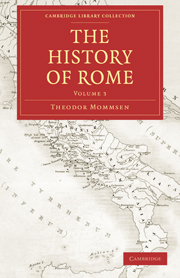Book contents
- Frontmatter
- PREFATORY NOTE
- Contents
- BOOK FOURTH: THE REVOLUTION
- CHAPTER I THE SUBJECT COUNTRIES DOWN TO THE TIMES OF THE GRACCHI
- CHAPTER II THE REFORM MOVEMENT AND TIBERIUS GRACCHUS
- CHAPTER III THE REVOLUTION AND GAIUS GRACCHUS
- CHAPTER IV THE RULE OF THE RESTORATION
- CHAPTER V THE PEOPLES OF THE NORTH
- CHAPTER VI THE ATTEMPT OF MARIUS AT REVOLUTION AND THE ATTEMPT OF DRUSUS AT REFORM
- CHAPTER VII THE REVOLT OF THE ITALIANS AND THE SULPICIAN REVOLUTION
- CHAPTER VIII THE EAST AND KING MITHRADATES
- CHAPTER IX CINNA AND SULLA
- CHAPTER X THE SULLAN CONSTITUTION
- CHAPTER XI THE COMMONWEALTH AND ITS ECONOMY
- CHAPTER XII NATIONALITY, RELIGION, AND EDUCATION
- CHAPTER XIII LITERATURE AND ART
- CORRECTIONS
CHAPTER IV - THE RULE OF THE RESTORATION
Published online by Cambridge University Press: 05 October 2010
- Frontmatter
- PREFATORY NOTE
- Contents
- BOOK FOURTH: THE REVOLUTION
- CHAPTER I THE SUBJECT COUNTRIES DOWN TO THE TIMES OF THE GRACCHI
- CHAPTER II THE REFORM MOVEMENT AND TIBERIUS GRACCHUS
- CHAPTER III THE REVOLUTION AND GAIUS GRACCHUS
- CHAPTER IV THE RULE OF THE RESTORATION
- CHAPTER V THE PEOPLES OF THE NORTH
- CHAPTER VI THE ATTEMPT OF MARIUS AT REVOLUTION AND THE ATTEMPT OF DRUSUS AT REFORM
- CHAPTER VII THE REVOLT OF THE ITALIANS AND THE SULPICIAN REVOLUTION
- CHAPTER VIII THE EAST AND KING MITHRADATES
- CHAPTER IX CINNA AND SULLA
- CHAPTER X THE SULLAN CONSTITUTION
- CHAPTER XI THE COMMONWEALTH AND ITS ECONOMY
- CHAPTER XII NATIONALITY, RELIGION, AND EDUCATION
- CHAPTER XIII LITERATURE AND ART
- CORRECTIONS
Summary
Vacancy in the government
The new structure, which Gaius Gracchus had reared, became on his death a ruin. His death indeed, like that of his brother, was primarily a mere act of vengeance; but it was at the same time a very material step towards the restoration of the old constitution, when the person of the monarch was taken away from the monarchy just as it was on the point of being established. It was all the more so in the present instance, because after the fall of Gaius and the sweeping and bloody prosecutions of Opimius there existed at the moment absolutely no one, who, either through relationship to the fallen chief of the state or through pre-eminent ability, could feel himself warranted in even attempting to occupy the vacant place. Gaius had departed from the world childless, and the son whom Tiberius had left behind him died before reaching manhood; the whole popular party, as it was called, was literally without any one who could be named as leader. The Gracchan constitution resembled a fortress without a commander; the walls and garrison were uninjured, but the general was wanting, and there was no one to take possession of the vacant place save the very government which had been overthrown.
There stored aristocracy
So it accordingly happened. After the decease of Gaius Gracchus without heirs, the government of the senate as it were spontaneously resumed its sway; and this was the more natural, that it had not been, in the strict sense, formally abolished by Gaius Gracchus, but had only been reduced to a nullity in point of fact by his exceptional proceedings.
- Type
- Chapter
- Information
- The History of Rome , pp. 131 - 165Publisher: Cambridge University PressPrint publication year: 2010First published in: 1863



